Optimization of Weighted Geometrical Center Method for PI and PI-PD Controllers
Abstract
:1. Introduction
2. Methodology and Simulations
2.1. Stability Region and WGC-Based PI Controller Design

2.2. Optimization Process of WGC Method
3. Results and Discussion
4. Conclusions
Funding
Data Availability Statement
Conflicts of Interest
References
- Åström, K.J.; Panagopoulos, H.; Hägglund, T. Design of PI Controllers Based on Non-Convex Optimization. Automatica 1998, 34, 585–601. [Google Scholar] [CrossRef]
- Shamsuzzoha, M.; Skogestad, S. The Setpoint Overshoot Method: A Simple and Fast Closed-Loop Approach for PID Tuning. J. Process Control 2010, 20, 1220–1234. [Google Scholar] [CrossRef]
- Onat, C.; Daşkin, M. WGC Based PI Controller Design for Integrated Systems with Time Delay and Inverse Response. In Proceedings of the National Automatic Control Conference (TOK 2013), Malatya, Türkiye, 26–28 September 2013. [Google Scholar]
- Åström, K.; Hägglund, T. The Future of PID Control. Control Eng. Pract. 2001, 9, 1163–1175. [Google Scholar] [CrossRef]
- Zhuang, M.; Atherton, D.P. Automatic Tuning of Optimum PID Controllers. IEE Proc. D Control Theory Appl. 1993, 140, 216–224. [Google Scholar] [CrossRef]
- Ho, M.; Datta, A.; Bhattacharyya, S.P. A New Approach to Feedback Stabilization. In Proceedings of the 35th IEEE Conference on Decision and Control, Kobe, Japan, 13 December 1996; IEEE: New York, NY, USA, 1996. [Google Scholar]
- Ho, M.; Datta, A.; Bhattacharyya, S. A Linear Programming Characterization of All Stabilizing PID Controllers. In Proceedings of the 1997 American Control Conference, Albuquerque, NM, USA, 6 June 1997; IEEE: New York, NY, USA, 1997. [Google Scholar]
- Söyletmez, M.T.; Munro, N.; Baki, H. Fast Calculation of Stabilizing PID Controllers. Automatica 2003, 39, 121–126. [Google Scholar] [CrossRef]
- Munro, N.; Söyletmez, M.T. Fast Calculation of Stabilizing PID Controllers for Uncertain Parameter Systems. IFAC Proc. Vol. 2000, 33, 549–554. [Google Scholar] [CrossRef]
- Tan, N.; Atherton, D.P. Feedback Stabilization Using the Hermite-Biehler Theorem. In Proceedings of the International Conf. on the Control of Industrial Processes, Newcastle, UK, 30–31 March 1999; pp. 254–256. [Google Scholar]
- Ackermann, J.; Kaesbauer, D. Design of Robust PID Controllers. In Proceedings of the Eurpean Control Conference (ECC), Porto, Portugal, 4–7 September 2001; pp. 522–527. [Google Scholar]
- Shafiei, Z.; Shenton, A.T. Frequency-Domain Design of Pid Controllers for Stable and Unstable Systems with Time Delay. Automatica 1997, 33, 2223–2232. [Google Scholar] [CrossRef]
- Huang, Y.J.; Wang, Y.J. Robust PID Tuning Strategy for Uncertain Plants Based on the Kharitonov Theorem. ISA Trans. 2000, 39, 419–431. [Google Scholar] [CrossRef]
- Chen, Z.; Zha, H.; Peng, K.; Yang, J.; Yan, J. A Design Method of Optimal PID-Based Repetitive Control Systems. IEEE Access 2020, 8, 139625–139633. [Google Scholar] [CrossRef]
- Alyoussef, F.; Kaya, I.; Akrad, A. Robust PI-PD Controller Design: Industrial Simulation Case Studies and a Real-Time Application. Electronics 2024, 13, 3362. [Google Scholar] [CrossRef]
- Lennartson, B.; Kristiansson, B. Evaluation and Tuning of Robust PID Controllers. IET Control Theory Appl. 2009, 3, 294–302. [Google Scholar] [CrossRef]
- Turan, A. PID Controller Design with a New Method Based on Proportional Gain for Cruise Control System. J. Radiat. Res. Appl. Sci. 2024, 17, 100810. [Google Scholar] [CrossRef]
- Daful, A.G. Comparative Study of PID Tuning Methods for Processes with Large & Small Delay Times. In Proceedings of the 2018 Advances in Science and Engineering Technology International Conferences, ASET 2018, Dubai, Sharjah, Abu Dhabi, United Arab Emirates, 6 February–5 April 2018; pp. 1–7. [Google Scholar] [CrossRef]
- Han, X. Comparative Study on PID for DC Motor Speed Regulation. MATEC Web Conf. 2024, 404, 02003. [Google Scholar] [CrossRef]
- Onat, C. A new concept on pi design for time delay systems: Weighted geometrical center. Int. J. Innov. Comput. Inf. Control ICIC Int. C 2013, 9, 4. [Google Scholar]
- Onat, C. WGC Based Robust and Gain Scheduling PI Controller Design for Condensing Boilers. Adv. Mech. Eng. 2014, 2014, 659051. [Google Scholar] [CrossRef]
- Ozyetkin, M.M.; Onat, C.; Tan, N. PID Tuning Method for Integrating Processes Having Time Delay and Inverse Response. IFAC-PapersOnLine 2018, 51, 274–279. [Google Scholar] [CrossRef]
- Turan, A.; Aggümüş, H.; Daşkın, M. PI-PD Controller Design Based on Weighted Geometric Center Method for Time Delay Active Suspension Systems. Black Sea J. Eng. Sci. 2024, 7, 89–95. [Google Scholar] [CrossRef]
- İrgan, H.; Menak, R.; Tan, N. A Comparative Study on PI-PD Controller Design Using Stability Region Centroid Methods for Unstable, Integrating and Resonant Systems with Time Delay. Meas. Control 2024, 58, 245–265. [Google Scholar] [CrossRef]
- Ajiboye, A.T.; Opadiji, J.F.; Yusuf, A.O.; Popoola, O.; Olawole, E.T.; Adebayo, O.F. New Methods for Proportional-Integral Controller Design for Time-Delay Systems. Indones. J. Electr. Eng. Comput. Sci. 2022, 28, 1437–1450. [Google Scholar] [CrossRef]
- Govindan, V.; Jayaprakash, J.; Park, C.; Lee, J.R.; Cangul, I.N.; History, A. Optimization-Based Design and Control of Dynamic Systems. Babylon. J. Math. 2023, 2023, 30–35. [Google Scholar] [CrossRef]
- Stenger, D.; Abel, D. Benchmark of Bayesian Optimization and Metaheuristics for Control Engineering Tuning Problems with Crash Constraints. arXiv 2022, arXiv:2211.02571. Available online: https://arxiv.org/abs/2211.02571v1 (accessed on 20 January 2025).
- Sun, X.; Liu, N.; Shen, R.; Wang, K.; Zhao, Z.; Sheng, X. Nonlinear PID Controller Parameters Optimization Using Improved Particle Swarm Optimization Algorithm for the CNC System. Appl. Sci. 2022, 12, 10269. [Google Scholar] [CrossRef]
- Tabassum, N.; Jahan, E.; Goswami, N.; Zishan, M.S.R. Performance Analysis of Automatic Generation Control for a Multi-Area Interconnected System Using Genetic Algorithm and Particle Swarm Optimization Technique. AIUB J. Sci. Eng. 2024, 23, 42–53. [Google Scholar] [CrossRef]
- Tan, N.; Atherton, D.P. Design of Stabilizing PI and PID Controllers. Int. J. Syst. Sci. 2006, 37, 543–554. [Google Scholar] [CrossRef]
- Tan, N.; Kaya, I.; Yeroglu, C.; Atherton, D.P. Computation of Stabilizing PI and PID Controllers Using the Stability Boundary Locus. Energy Convers. Manag. 2006, 47, 3045–3058. [Google Scholar] [CrossRef]
- Chu, M. Graphical Tuning Method of PID Controller for Systems with Uncertain Parameters Based on Affine Algorithm. Int. J. Robust. Nonlinear Control 2024, 34, 12207–12222. [Google Scholar] [CrossRef]
- Ozyetkin, M.M.; Onat, C.; Tan, N. PI-PD Controller Design for Time Delay Systems via the Weighted Geometrical Center Method. Asian J. Control 2020, 22, 1811–1826. [Google Scholar] [CrossRef]
- Pai, N.S.; Chang, S.C.; Huang, C.T. Tuning PI/PID Controllers for Integrating Processes with Deadtime and Inverse Response by Simple Calculations. J. Process Control 2010, 20, 726–733. [Google Scholar] [CrossRef]

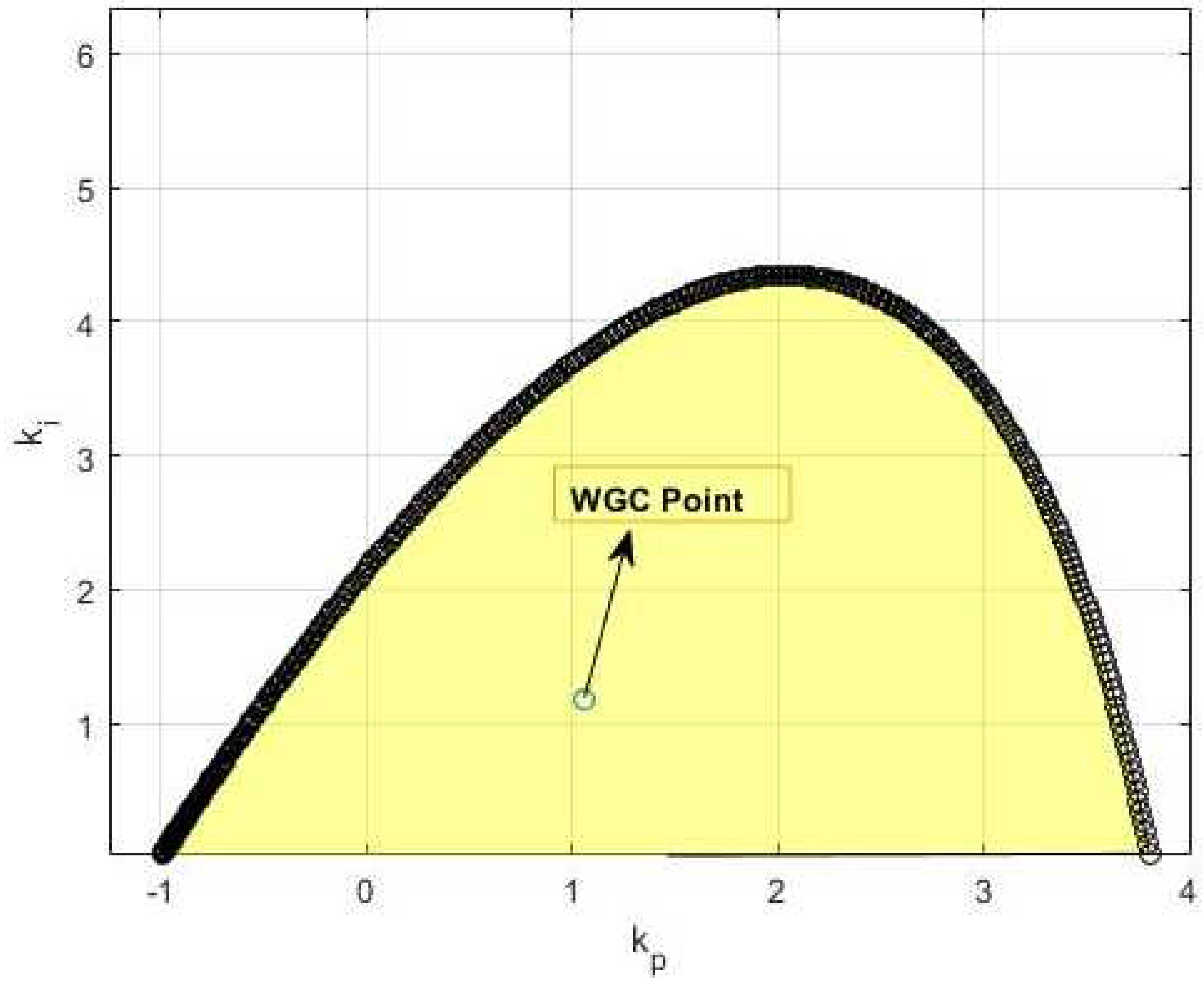


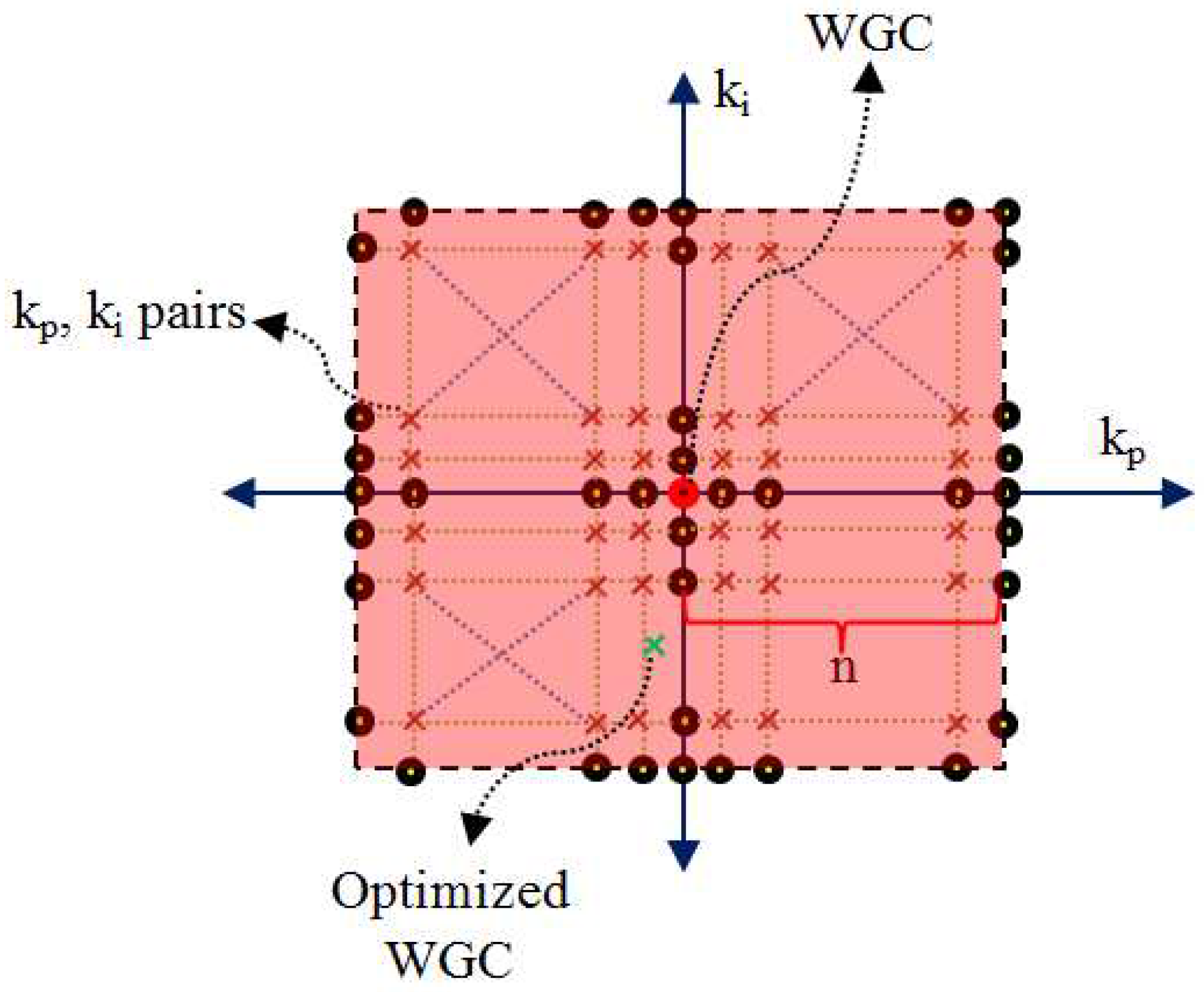
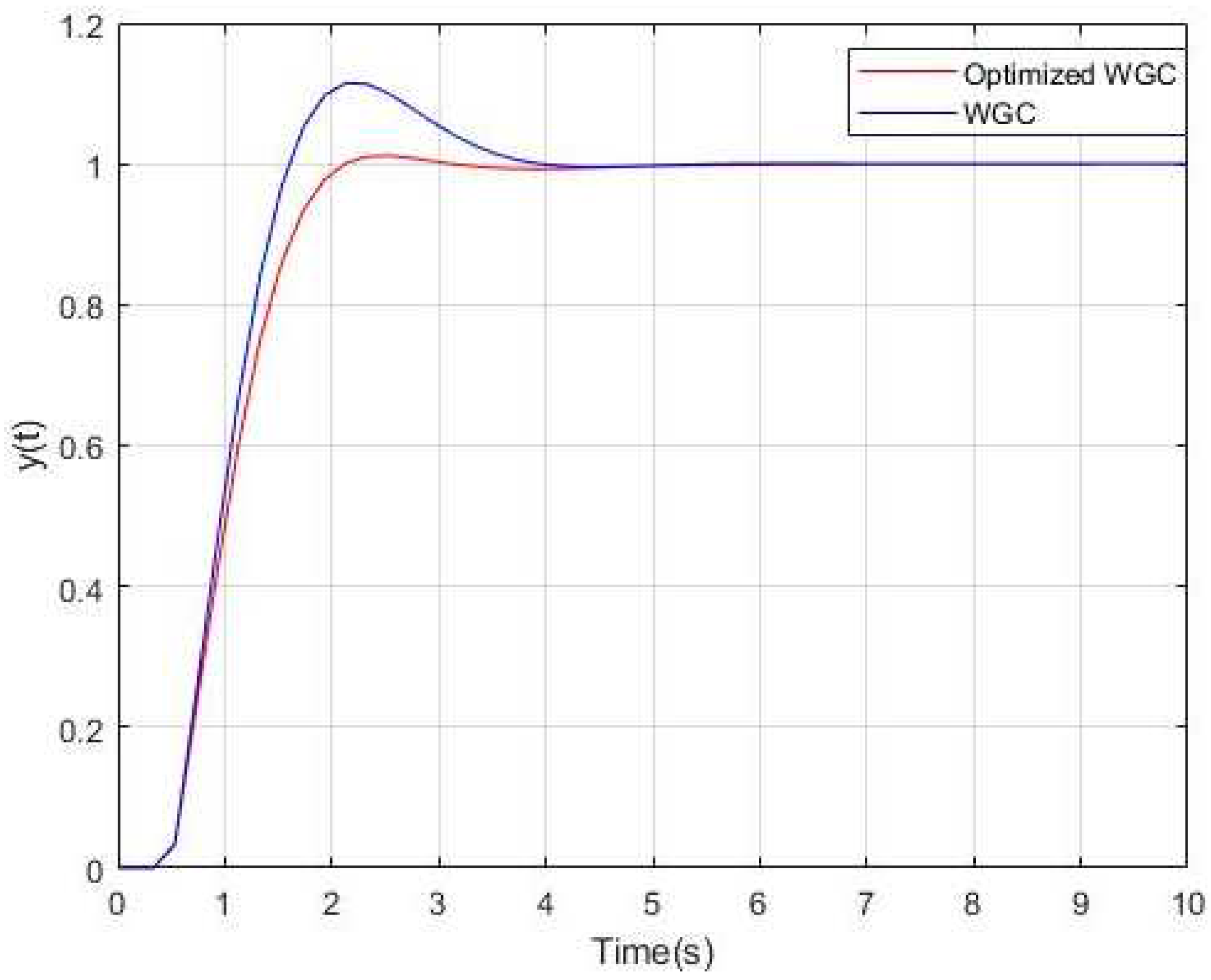
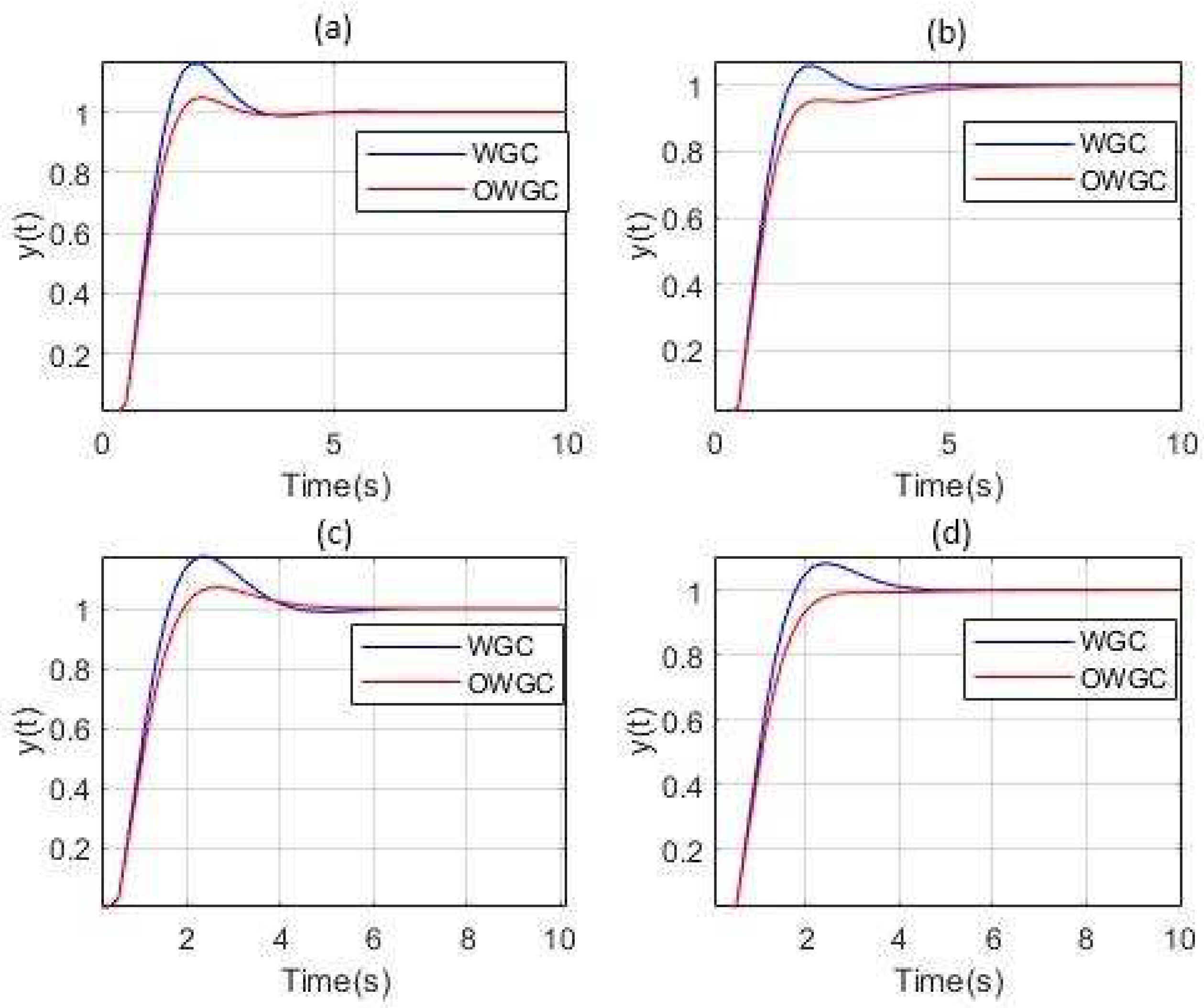
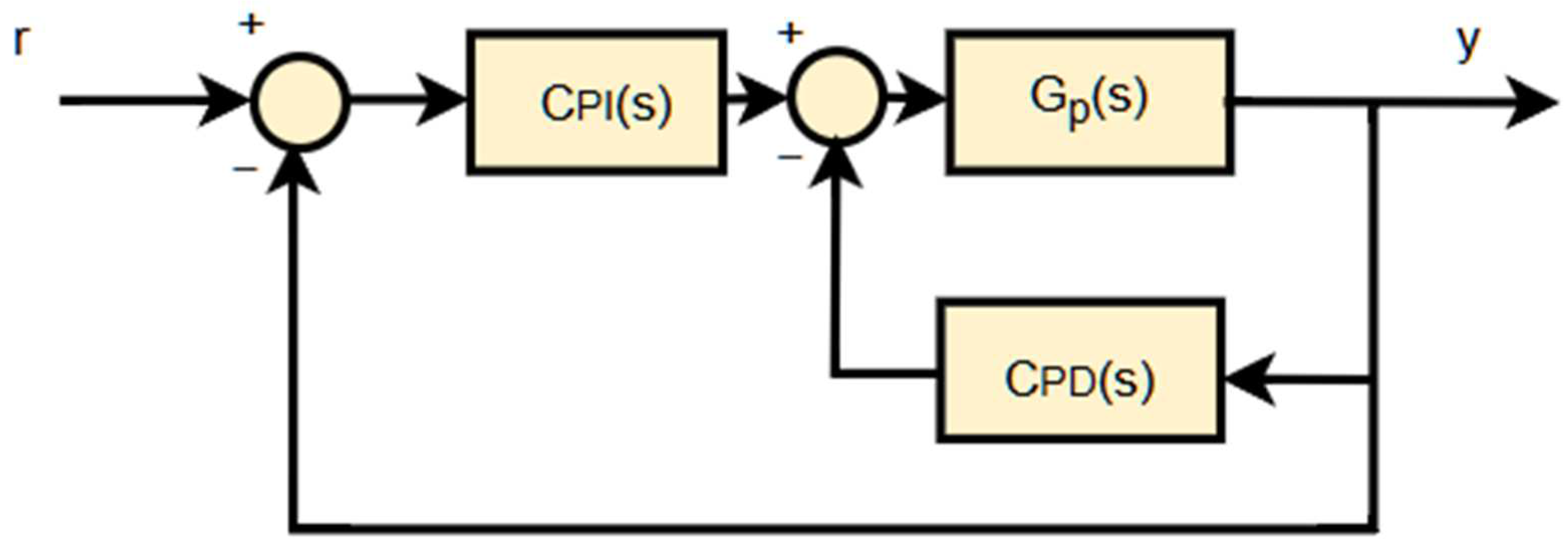



| Controllers | %Os | tr(s) | ts(s) | J |
|---|---|---|---|---|
| WGC | 11.52 | 0.81 | 3.39 | 5.24 |
| OWGC | 0.96 | 1.01 | 1.94 | 1.30 |
| Controllers | %Os | tr(s) | ts(s) | J |
|---|---|---|---|---|
| WGC | 58.53 | 7.33 | 92.83 | 52.89 |
| OWGC | 59.08 | 7.04 | 91.48 | 52.53 |
| Pai | 79.03 | 5.98 | 115.14 | 66.71 |
Disclaimer/Publisher’s Note: The statements, opinions and data contained in all publications are solely those of the individual author(s) and contributor(s) and not of MDPI and/or the editor(s). MDPI and/or the editor(s) disclaim responsibility for any injury to people or property resulting from any ideas, methods, instructions or products referred to in the content. |
© 2025 by the author. Licensee MDPI, Basel, Switzerland. This article is an open access article distributed under the terms and conditions of the Creative Commons Attribution (CC BY) license (https://creativecommons.org/licenses/by/4.0/).
Share and Cite
Daskin, M. Optimization of Weighted Geometrical Center Method for PI and PI-PD Controllers. Processes 2025, 13, 749. https://doi.org/10.3390/pr13030749
Daskin M. Optimization of Weighted Geometrical Center Method for PI and PI-PD Controllers. Processes. 2025; 13(3):749. https://doi.org/10.3390/pr13030749
Chicago/Turabian StyleDaskin, Mahmut. 2025. "Optimization of Weighted Geometrical Center Method for PI and PI-PD Controllers" Processes 13, no. 3: 749. https://doi.org/10.3390/pr13030749
APA StyleDaskin, M. (2025). Optimization of Weighted Geometrical Center Method for PI and PI-PD Controllers. Processes, 13(3), 749. https://doi.org/10.3390/pr13030749





